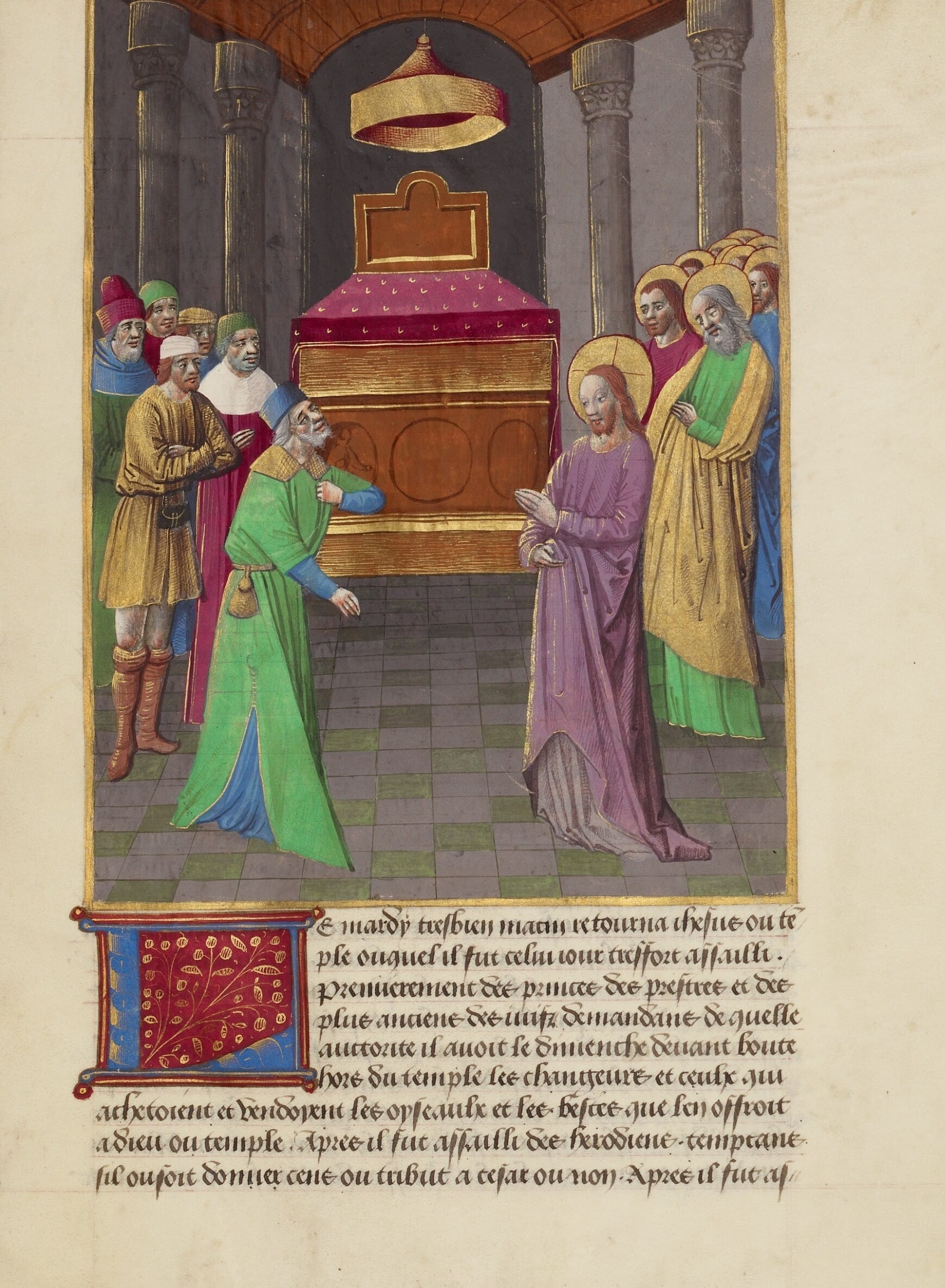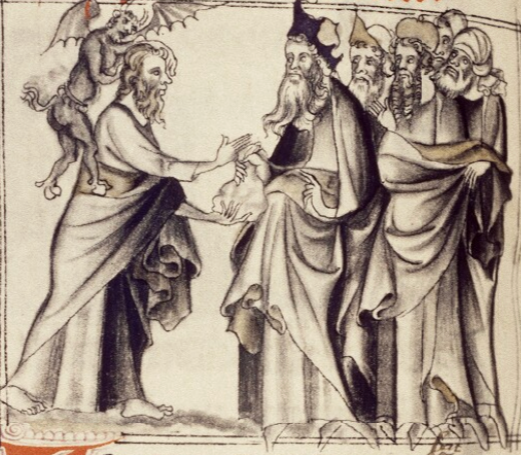Jesus and the Jews: Part One
The first of a 3-part series on the Gospels and Jewish text

This is Life as a Sacred Text 🌱, an everybody-celebrating, justice-centered voyage into ancient stories that can illuminate our own lives. It‘s run on a nonprofit, so it’s 100% NAZI FREE. More about the project here, and to subscribe, go here:
A long, long time ago, on a website formerly known as the twitters, I laid out my argument for why I think Jesus of Nazareth sure could have been a Pharisee, citing specific Jewish and Christian texts to make my case. There have since been requests for it to be re-shared, and since the whole thing could use some fleshing out anyway, I decided to do the thing properly (including nuancing and clarifying in ways that I didn't back then.)
This will be a ✨THREE PART SERIES ✨, because there’s a lot to cover. This week will be largely about setting the stage. Next week, we'll set a tiny bit more stage and do a deep-ish dive into one particular chapter of the Gospels; two weeks from now will be more of a textual sample platter, if you will.
If you’re not a Life is a Sacred Text subscriber yet, fix that right now!
To get Parts Two and Three,
As always, green underlined is probably a link/URL.
First, some background.
I'm going heavy on all this a) because it’s interesting! Learn something.
And b) because I think the argument I’m making will make a lot more sense with context. OK? OK!
As a refresher from the Big Big Mega History Text History Post and The Antisemitism Post (tm), Rome conquers Judea in 63 BCE, and then becomes much more involved with running the place in 6 CE.
During this later Second Temple Era, the time in which Jesus appears on the scene, there are a lot of different kinds of Jews running around the Holy Land, with a lot of different kinds of philosophies and relationships to various institutional powers. (Same as it ever was.)
Some of the major groups included:
Tzadokim/Sadducees The priests and their people, the authority of the Temple, often political leaders, more of the aristocratic/elites in town. It’s a long story, but the ancient, legitimate line of succession of the High Priest Tzadok got mucked up somewhere along the way. Nonetheless, by the late Second Temple era (as we're just tuning in,) the priests still call themselves Tzadokim in an attempt to legitimize their presence, even though the High Priest at this point is no longer the legit heir of Tzadok. These Tzadokim believed in only the Written Torah, not the Oral Torah– that is, the addition of Jewish legal principles beyond the Torah itself that eventually became codified in the Mishnah. They also didn’t believe in the resurrection of the dead.
Prushim/Pharisees The "heretics" and/or "restrained ones" most likely, though some think “separated-out ones” or "interpreters” is a better translation. (1) These are the guys mentioned all over the Gospels in debate with Jesus. They were a more democratizing group that held by not only the Written Torah (the Pentateuch) but also the Oral Torah (which eventually got codified as the Mishnah) and spent a lot of time debating the particulars of Jewish law. They’re sages. They’re—along with some of the Tzadokim—the dudes on the Sanhedrin (the Second Temple Knesset/SCOTUS.) (2) They’re almost certainly one and the same as what we call in Jewville the early Tanaaim–that is, some of the sages (or their teachers or grand-teachers etc) who will be part of the Mishnah. In other words, they're the ancestors of the Rabbinic tradition that saved Judaism after the Second Temple was destroyed, and a direct line to my own ordination. (I might use Tanaaitic/Pharisaic/Rabbinic pretty much interchangeably in these missives for a certain kind of simplicity's sake, even if some folks might quibble about that.)
Isiyim/Essenes aka Cave Hippies, most likely the Qumran (Dead Sea Scroll) community. (Though, just to give you a sense of how complicated this all is, some scholars think the Essenes and the Qumran folks could have been two separate groups.) Mystic ascetics who probably splintered off ca. 161-143 BCE, during the Hasmonean era (aka the reign of the Maccabees, the Hanukah guys—their monarchy ruled before the Romans came in). And the breakaway issue was likely about disputes re: the High Priest’s line. See above with the Tzadokim and “succession got mucked up somewhere in there”—these folks weren’t having it, and claimed that they were carrying on the authentic work. They were big into tumah/tehorah stuff, favored priests over laypeople, were into hierarchy and dualism.
Kana'im/Zealots— Zealous on behalf of God. These guys show up towards the end of the Second Temple era, are in it to get the rest of the Jews to rise up and revolt against the Roman Empire. They're successful in that; the Great Jewish Revolt broke out in 66 CE. They are here for violence—the Rabbis in the Mishnah and Talmud call them biryonim, bullies, and talk about them doing things like, during the Roman siege of Jerusalem, burning decades worth of food and firewood to get the people to fight out of desperation. Not a good look. There’s also a splinter group, called the Sicarii, named as such because they carried sicae, or small daggers, under their cloaks. The Sicarii were evidently more into the social revolution aspect of the thing. (3)
Samaritans are an ethnoreligious group that share Israelite ancestry with Jews. Per tradition, they were from the tribes of Ephriam and Menashe, and/but didn't end up exiled after the Assyrians conquered the Kingdom of Israel in 720 BCE. They regard their version of the Pentateuch and rituals as the original version of the Israelite religion; one key difference is that their holiest site is Mount Gerizim, near the Biblical city of Shechem and the contemporary West Bank city of Nablus. (They're still around today; their tahini is excellent and can be found many places online.)
There are others (Hemerobaptists! Tovelei Shaharit! Bana'im! Boethusians!) but we only have so much time.
Anyway, this is the backdrop in which Jesus, a Jew, appears and teaches. He is executed by the Romans, using a classically Roman method of execution. (4) His initial followers are Jewish. (Notably, the majority of Jews at this time likely wouldn't have felt they were part of, or even sympathizers, to any particular group.)
Initially, the Jesus Movement was just another of these various movements of Jews running around Judea. Another charismatic leader, another inspired set of followers, galvanized even further after his death. (5)
From the Jewish perspective, the fact
a) that Jesus did not free Judea from the Romans and
b) that the Romans then killed him
caused many to reject him as the Messiah pretty early on. And a lot of folks were expecting the Messiah to be more of a military leader (a la Bar Kochba.)
But, as Rabbinics scholar Daniel Boyarin put it,
“Many Jews were expecting a divine-human Messiah.... Many accepted Jesus as that figure, while others did not. Although there is precious little pre-Christian evidence among Jews for the suffering of the Messiah, there are good reasons to consider this too no stumbling block for the “Jewishness” of the ideas about the Messiah, Jesus as well. Let me make clear that I am not claiming that Jesus and his followers contributed nothing new to the story of a suffering and dying Messiah; I am not, of course, denying them their own religious creativity. I am claiming that this innovation, if indeed they innovated, was entirely within the spirit and hermeneutical method of ancient Judaism, and not a scandalous departure from it.”
Of course, there will eventually be a break.
In 49 CE, Paul of Tarsus made the call that adherents of this new movement who weren’t already Jewish wouldn’t need to be circumcised—a requirement for conversion to Judaism. Rather, they'd just need to observe a version of what eventually get formulated as the Noahide Commandments—the handful of mitzvot that non-Jews are obligated to observe, per God’s covenant with all of humanity at the end of the Noah and the flood story. No murder, no robbery, no idolatry, that kind of thing. But tl;dr?
New followers don’t need to become Jews to join the Jesus movement.
Obviously, “Christians” wasn’t a monolithic group in the first couple of centuries CE.
In fact, as New Testament scholar AKM Adam (whose notes are all over this post– thank you again, AKMA!!) reminds me, the word "Christian" is a misnomer until much later in the game. It takes time for "Jesus followers," to evolve into a different kind of movement.
The fact that you had Jewish Jesus fans living basically Jewish lives and then non-Jews whose religious identity involved following Jesus but not as Jews– was significant.
It’s a hectic time!
In 66 CE, the Jews try to overthrow the Romans in the Great Jewish Revolt like their Maccabee ancestors did to the Selucids in 160 BCE.
But that goes... badly.
The Revolt culminates in the Romans destroying the Temple in Jerusalem in 70 CE, which was a level of collective catastrophe so great we have a holiday mourning about it still, almost 2000 years later.
In 132 CE, the Jews revolt again, this time led by Simon Bar Koseba, nicknamed Bar Kochba. (6) It fails, miserably, and the Romans kill, enslave, or expel just about all the Jews from Jerusalem and many from elsewhere in Judea. (This is from when we date the beginning of our galut, exile, Diaspora.) At this point, the Jewish Jesus groups enter a terminal decline, and the non-Jewish Jesus followers wind up taking over all these spaces in the bourgeoning (can we call it, yet?) Christianity—in leadership and in every other way. (7)
Introducing.... The Gospels
Here are a few historical notes about the Gospels' authorship and audience. This matters for the journey I’m bringing you on, I promise.
Mark was written in Greek, by a non-Jew, and most scholars believe that it was written anonymously for a non-Jewish audience, probably in Rome, either right before or right after the Temple was destroyed in 70 CE.
Prof. AKM Adam put it this way:
"I tend to think of Mark as a diasporic one-foot-in-the-synagogue guy, the kind of 'ally' who explains things on Twitter, but gets a lot wrong." (8)
Matthew was written after the destruction of Temple, by someone who used Mark as a base, as well as other possible source material that scholars have yet to locate (sources known as “M” and “Q” in the scholarly world).
It’s generally believed that Matthew's audience was made up of Greek-speaking Jewish Jesus movement folks—and that the major tension between Matthew's community and other Jewish communities was that Matthew's community believed not only that Jesus was the Messiah, but that, as such, he was the authoritative interpreter of Jewish law, and the fulfillment of Judaism.
Was there was one Jewish author? An author drawing on local traditions, some of which were Jewish? Were there layers of composition– and one layer involved a Jewish follower of Jesus and another involved a non-Jewish member of this new movement? We may never know. (9)
Some scholars locate its authorship in Antioch, Syria, in a community where the Jesus movement's non-Jewish population had exploded, putting the Jews among their ranks in a precarious position. And after the failure of the Great Jewish Revolt (regarded by many non-Jews as a pathetic attempt by a fanatic fringe), Jews in Antioch, as in many places, were harassed and murdered by non-Jews. The Jesus movement Jews, in this milieu, may have wanted to distance themselves from those Jews in several places, and show how much more they had in common with the other Jesus movement folks.
Luke (and Acts) were written ca. 80-110 CE or so. There are a lot of open questions about authorship—it’s written in fancy polished Greek, but there are also Jew-isms that could have been from an outside source or not, we don't know. (Like Matthew, it drew from Mark and other sources.) Bottom line is this: It was probably written to be read aloud to a group of educated Greek-speaking Jesus-followers gathered together, addressing concerns specific to their movement.
Its message is that this Jesus movement is the continuation of "authentic" Judaism–and the Jews rejected Jesus, the true prophet. At the same time, it tries to show that, despite the fact that their original leader was executed as a political criminal by the Roman State, his followers are good citizens of the Empire. They go in on respectability; Jesus is depicted as a nice teacher of ethical wisdom, and guess who gets scapegoated? EG Luke paints a reluctant Pontius Pilate and bloodthirsty Yids demanding that Jesus be executed... according to a Roman means of execution. But this narrative plays well on their favorite new song, Christians Can Be Good Romans (We've Got No Beef With You, Caesar Domitianus Augustus Sir! Remix )
John was written ca. 90-110 CE. This text describes Jesus as descending into human history from above, superseding that which came before, rejected by his own people (of course: the Jews). There's a lot of acrimony: He goes in on the "Jews killed Jesus" thing, claims that Jews are devil's spawn (John 8:44!), and more. There's debate about which community the author was a part; some scholars think that John was writing from a Jewish community that had already begun to separate itself from other Jewish communities through its devotion to Jesus as the revelation of the divine, as access through the Holy Spirit. Others look at how John talks about "the Jews" and assume that it tracked with how non-Jews talked back then– and suggest that John doesn't seem to know a lot about Jewish traditions and customs. In any case, John isn't warm and fuzzy, from the Yid POV.

So here’s the thing: EVEN THOUGH Judaism and what's now called Christianity had not separated out into fully distinct, entirely separate religions at this point, you can probably see from my descriptions of the Gospels above, as well as the descriptions of the various Jewish sects the beginning of this post, this doesn’t mean that there weren’t… tensions. And fissures.
This began after the death of Jesus and the fact that some Jews really didn’t get on board with the Jesus Agenda because of how that all went down.
It compounded after the Great Fire of Rome in 64 CE– the Emperor Nero decided to divert attention away from his own failures by going after an easy target: the Jesus followers, whom he tortured and killed– likely increasing that movement's anxiety about, and fear of, Rome.
Then the Great Jewish Revolt and the destruction of the Temple went down—there may not have been an immediate wholesale rejection of “Judaism,” by the Jesus camp but that doesn’t mean that there weren’t groups of Jews increasingly taking sides or feeling increasingly snipey at one another, or that the various Jesus contingents weren't part of that.
Questions like:
- Who supported the Revolt?
- Who was most hurt by it?
- How should we make sense of the fact that our most sacred place was decimated by the occupying empire?
- What should we do now????
were live, and real.
You can see how a nascent Jewish Jesus movement and a nascent non-Jewish Jesus movement might parse all of this differently than—well, go back to the list of other groups at the beginning of this missive and try to imagine how each might have answered these questions.
So IF Jesus was a Pharisee—a tanna— or had any of those kinds of inclinations, if he was a fellow who moved between worlds (just as some people do today, and as Josephus, a few decades after Jesus, acknowledges that he did for some time), (9) or if he played that way sometimes—well, one might imagine that the authors of the Gospels might be motivated to distance Jesus from his Pharisaic-ness, because they themselves were already in the process of breaking up with them.
It may have been conscious, it may not have been, but think about how many people write or talk differently about their exes after the relationship ends—especially if there is acrimony—as opposed to while they’re together. Even if things were going great at the time, the ex is not always portrayed in the most flattering light after the fact, are they?
As Cook put it,
the enmity towards Jews of the [Gospel authors'] day (70-100) was retrojected to Jesus (ca. 30), not that any enmity toward Jews by the historical Jesus was forwarded. (10)
A bit to consider?
We will get deeper into the question of Jesus the Pharisee (?) next week, finally starting to do some compare and contrast between Gospel texts and those from my side of the aisle.
(Parts Two and Three are up! They are here and here. Please read on and spread the word!)
🌱🌱🌱🌱🌱🌱🌱🌱🌱🌱🌱🌱🌱🌱🌱🌱🌱🌱🌱🌱🌱🌱🌱🌱🌱
Like this? Get more of it in your inbox every week. 🌱
For free every Monday—sign up at the ‘Subscribe now’ button just below.
And if you become a paid subscriber, that's how you can get tools for deeper transformation, a community for doing the work, and support the labor that makes these Monday essays happen.
A note on the subscription model:
I want my work to be as accessible to as many people as possible, in as many ways as possible. That's why the Monday essays are free, and why we donate subscriptions to anyone for whom paying is a barrier to the House of Study posts.
I also believe people should be paid fairly for their work. Needless to say, these two values sometimes seem to be in conflict, but I do what I can to find a fair balance. I offer many resources for free, and charge for others. When you donate generously or pay at the top of our scale, that helps support the work I do, provides access for those who have fewer resources, pays for the infrastructure and the technical and practical support that it takes to do this, and helps us keep the work sustainable.
And as always, if you want in to the Thursday space but paying isn't for you now, just email support@lifeisasacredtext.com and we'll hook you up.
And if you’d like to underwrite one of these donated subscriptions, you can do so by signing up at one of the higher subscription points.
And if it resonated with you, please share this post.
Sending a big pile of blessings and goodness your way. 💕
If you are not yet getting these missives, make sure to fix that immediately, because it's going to start getting juicy. 👀
FOOTNOTES
- Depending on whose translation you hold by.
- I think the Temple is the Executive Branch in this poor, tortured metaphor, with the High Priest as president? The Essenes left in protest. ANYWAY. (Seriously, though: there's a lot we don't know about how the Sanhedrin functioned, or who even comprised it.).
More importantly, the whole "Pharisees" thing has a whole backstory.
As the great Professor Louis Finkelstein put it,
"As is known, the Pharisees called the founders of their sect Pietists, חסידים/hasidim. So Yosef ben Yo'ezer is called "the most pious among the priesthood" (Mishnah Chagigah 2:7), likely because he joined with the sect of the Pietists, despite the fact that most of the priests were among their opponents. In my poor understanding, the Pharisees never stopped seeing their sect as the Sect of the Pietists, but their opponents began to insult them by calling them the Pharisees, meaning 'heretics'."
Professor Shaye Cohen theorizes that we don't see a strong connection between Pharisees and the early Mishnaic (post-Temple) Rabbis because the latter wanted to distance themselves from their sectarian origins since, after the Temple's destruction, the Rabbis focused not on rigid ideology but preserving diversity of thought "in a grand coalition." So these later tanaaim distance themselves from both the "heretic" label– they're normative Judaism now, thank you very much!– and the sectarian vibe. But over time, later generations of Rabbis (amoraim) began to reach back for that historical connection and accept the name "Prushim" for themselves, changing the connotation to one of "abstinence" or "self-restraint." (Think: Keeping kosher in a stricter way, eg.) A rebrand. One can eventually see the association between the Pharisees and the Rabbis emerging clearly. (Jewnerds: Prof. Finklestein assumes that Tosefta Brachot 3:25 is the correct version, and that Yerushalmi Brachot 2:4 edited out the פ word after they began adopting it for themselves.)
3. As an enjoyer of the film/TV genre I have dubbed Horses And Swords, a show about the various Jews in Judea in the years leading up to the Great Revolt of 66 CE (and/or the Bar Kochba revolt, a clean 66 years later) would be a kickass show done well, I Am Just Saying. (Even if it might be heavier on donkeys and camels than horses—we’ll allow it.) @Netflix, call me.
4. Capital punishment is discussed in Rabbinic literature; there were four methods: stoning, burning, decapitation, and strangulation. (Nobody give the Heritage Foundation any ideas.) Of course, the death penalty in Rabbinic Judaism is a pretty complicated topic—it’s unclear how much their literature was based on actual implementation vs theory qua theory (sci fi, basically, since their power was so limited under the Romans), but it’s pretty clear that, regardless, they had a much higher bar for capital punishment than we do today (or 😬 than the Romans did.) (Best of all would be none, though: No state-sanctioned murder.)
5. I’m sorry, Christian friends. I agonized a bit about the pronoun thing—how to write this in a way that reflects both my own actual beliefs and that is respectful to you (since I know that most or all of you’d capitalize those pronoun Hs) and for a bit there was doing complicated sentence construction to avoid pronouns, or only using Jesus’ name (something I have done many times for Gender Reasons, Misc.) But this is a long essay and it was gonna get really hard to read if I kept doing that, so I’m going to go with better writing and stick with my own integrity and perspective on the thing. Consider this an exercise in non-hegemonic experience.
6. Bar Kochba, from the Hebrew/Aramaic word for star, kochav, in reference to the fact that the great tanna Rabbi Akiva and presumably others believed that he was the Messiah: "There shall come a star out of Jacob.” (Numbers 24:17)
7. Thanks to Woody Rosenberg for clarifying this point for me.
- Early Christian literatures professor Rabbi Dr. Michael Cook has this theory about Mark that's fascinating, but it's comparatively a lot of airtime for something that's got far from scholarly consensus, so I'm including it as a footnote here. The gist is that the betrayal of Judas was added in by Mark in the wake of Nero's persecution of the Jesus movement people in 64 CE, wherein they were tortured until they gave up and betrayed one another to the Roman state. (Claudius had expelled the Jewish Jesus movement leaders from Rome in 49 CE, so it was a 100% Gentile-Jesus movement party over there. And when the Jewish Jesus followers came back in the mid-50s, after Claudius' death, they found that the non-Jews "treated them with haughty condescension," as Cook put it. And, he claimed,
"From this rivalry there arose, within the Gentile-Christian camp, traditions that demeaned the symbolic forerunners of the Jewish-Christians (namely, Jesus' Jewish disciples), characterizing them as hapless, disloyal, and unworthy to be leaders, distortions that undermined the status of Jewish-Christian returnees to Rome. Such sediment of traditions became second nature to Mark, himself a Gentile-Christian within this church during the 60s, and in this natural fashion found entry into the Gospel he wrote years later."
So suddenly we have disciples who doubt, who are incompetent, who not even Jesus can convince he's Jesus. Cook suggests that Mark picked the disciple with– well, a name that had some biblical (((echoes))) to do some other work.
Just as Judah (one of 12 sons, tribes) betrays the eventual leader who trusted him (Joseph) by selling him for pieces of silver in the Book of Genesis (37:25-28), so too does Judas, one of 12 apostles. And it didn't hurt Mark's political agenda that the name had echoes to Judeans, Jews.

Cook posits that Mark was written in 72 CE, just after Titus marched hundreds of captives from the Great Jewish Revolt through the streets of Rome. This would have been a key moment for this non-Jewish Christian to feel incentivized to de-Judaize Jesus, to distance Jesus from his disciples and, possibly, his Pharisaic buddies.
- Matthew's Jewishness: A wholly Jewish author probably wouldn't have revised Mark 12:28 (etc). to Matthew 22:35, the way it stands now. That is, a discussion about the most important verse in Torah in Mark includes the recitation of the Sh'ma ("Hear Israel, God is God..."), one of the central liturgical moments in our tradition– but Matthew skips the Sh'ma and jumps straight to the V'ahavta ("You shall love God your God with all your heart...etc"). This is a perplexing choice to make from a Jewish perspective– but might be more comprehensible if one specifically wanted to distance Jesus from his Jewishness.
10. Josephus wrote in his autobiography,
”And when I was about sixteen years old [53CE], I had a mind to make trial of the several sects that were among us. These sects are three: the first is that of the Pharisees; the second that Sadducees; and the third that of the Essens; [sic] as we have frequently told you. For I thought that by this means I might choose the best, if I were once acquainted with them all. So I contented myself with hard fare; and underwent great difficulties; and went through them all....
"Don't worry about Joey, he's just in his Essene phase, honey. A lot of the kids these days are doing it. Yeah, I'm still tracking his phone."
11. I’ll note that Professor Michael Cook, a scholar of early Christian literatures, agrees with me that Jesus was likely a Pharisee himself.





